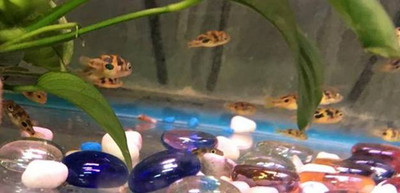Pea Pufferfish
Posted by Max Gandara on on 14th May 2025
Pea Pufferfish: The Tiny Titan of the Freshwater Aquarium
When it comes to aquarium fish, size isn’t everything—attitude is. The Pea Pufferfish (Carinotetraodon travancoricus), also known as the Dwarf Pufferfish, is proof of that. Despite being one of the smallest freshwater fish, it packs a big punch in terms of personality and charm. This little ball of energy is perfect for those who want to add a bit of feistiness to their tank.
Let’s dive into the world of the Pea Puffer and explore what makes this tiny titan so special!
What is a Pea Pufferfish?
The Pea Pufferfish is a species of freshwater pufferfish native to the backwaters and slow-moving streams of Kerala in southern India. It’s a small, active fish that grows to a maximum size of 1 inch (2.5 cm), making it one of the smallest pufferfish species available for aquariums.
Key Facts:
-
Scientific Name: Carinotetraodon travancoricus
-
Size: Up to 1 inch (2.5 cm)
-
Lifespan: 3–5 years
-
Tank Level: Mid to top swimmer
-
Temperament: Feisty, curious, and territorial
Pea Puffers are renowned for their round, compact bodies, and their signature bulging eyes that give them a comical, curious appearance. They are often called “freshwater dogfish” because of their inquisitive nature.
Water Parameters: Creating the Ideal Habitat
Pea Puffers are native to brackish waters in their natural habitat, though many are now bred in captivity in freshwater conditions. They prefer slightly acidic to neutral water and thrive in well-maintained, stable environments.
Water Parameters:
-
Temperature: 75–80°F (24–27°C)
-
pH: 6.5–7.5 (slightly acidic to neutral)
-
Water Hardness: Soft to moderately hard
-
Filtration: Gentle, but with strong biological filtration (they’re messy eaters!)
Pea Puffers are sensitive to poor water quality, so regular water changes (around 20–30% weekly) are important to keep them healthy.
Tank Setup: Small But Mighty
Because Pea Puffers are so tiny, many aquarists think they can be kept in small tanks. However, they are highly active and benefit from having ample space to explore.
Minimum Tank Size:
-
10 gallons for a small group (1–4 fish)
-
Larger tanks are better for a more natural environment
Tank Environment:
-
Substrate: Fine sand or gravel (avoid sharp edges)
-
Décor: Driftwood, rocks, and plants (live plants are great, but be mindful of their territorial behavior)
-
Hiding Spots: Pea Puffers enjoy having plenty of places to hide when they feel threatened
While they’re small, Pea Puffers are territorial, so it’s important to provide adequate space and hiding spots to reduce stress and prevent aggression, especially between males.
Diet: A Carnivorous Predator
Pea Puffers are carnivores with a strong hunting instinct, and their diet should consist of protein-rich foods. In the wild, they feed on small invertebrates and snails. In the aquarium, they require a varied diet to stay healthy and active.
Ideal Foods:
-
Live or frozen foods: Daphnia, bloodworms, brine shrimp, blackworms
-
Snails: They love eating small snails (which also helps keep their beaks trimmed)
-
Shrimp (small, thawed)
It’s essential to feed them a crunchy diet for dental health, as their beaks will continue to grow throughout their life. Offer food 2–3 times a day, and make sure to remove any uneaten food to maintain water quality.
Tank Mates: Caution with Companions
While Pea Puffers are small and cute, they have a feisty temperament and are known to be territorial. They can get aggressive with other fish, especially other small species or those with long, flowing fins.
Best Tank Mates:
-
Other Pea Puffers (in groups of 3–4, though watch out for aggression among males)
-
Small, active fish like Neon Tetras, Endler's Livebearers, and Small Rasboras
Avoid:
-
Long-finned fish like guppies or bettas (they might get nipped)
-
Larger or slow fish that can be bullied
-
Shrimp and other small invertebrates (they’ll likely be eaten)
For best results, keep Pea Puffers in species-only tanks or with carefully chosen, fast-moving, and hardy tankmates.
Behavior: Curious, Playful, and Aggressive
Pea Puffers are extremely intelligent and can display playful behaviors. They are known for their inquisitive nature and can often be seen swimming up to the glass to interact with their owner. They are also very territorial, and you may see them chase away other fish from their favorite spots.
-
Puffing up: When startled, the Pea Puffer may puff up its body in an attempt to appear larger. This behavior is often temporary and not a sign of stress unless it happens frequently.
-
Exploring: They are curious and will interact with new objects in the tank, like decorations or new plants.
Health Considerations
While Pea Puffers are relatively hardy, they do have some specific health concerns to watch out for.
-
Overgrown beaks: If not provided with crunchy food, their beaks can grow too large and cause feeding issues.
-
Skin problems: They can develop skin issues if kept in poor water quality.
-
Parasites: Like many freshwater species, they are prone to internal and external parasites, especially when first acquired.
To ensure your Pea Puffer remains healthy, quarantine new arrivals, maintain high water quality, and provide a varied, nutritious diet.
Final Thoughts
The Pea Pufferfish is a small fish with a big personality—perfect for aquarists who appreciate intelligent, quirky, and independent creatures. They are not for beginner aquarium hobbyists but can thrive in the right conditions with a little attention to their territorial needs and specialized diet.
For anyone looking for a fish that offers both entertainment and a challenge, the Pea Puffer will provide plenty of both. Their curious, playful nature, paired with their bold aggression and stunning appearance, makes them an absolute gem in the world of freshwater aquariums.
Pro Tip: If you're considering adding multiple Pea Puffers, ensure the tank is large enough to accommodate their territorial needs, and monitor their behavior closely.

